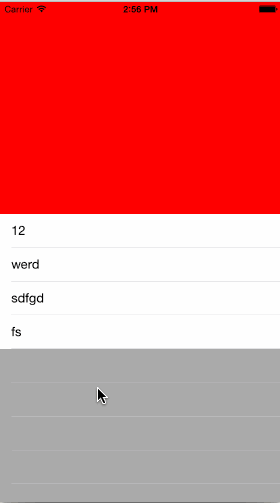效果图如下:
红色区域为headerView
核心思路
将自定义的headerView放在tabView 的上面,而不是作为tableView.tableHeaderView(即headerView和tableView平级,都添加到viewController的view上),然后设置tableView的contentInset为合适的值,在tableView滑动的时候,动态改变view的位置或者大小,使这个headerView看起来就像是有了悬浮功能的tableView.tableHeaderView。
核心代码如下:
mainTable = [[UITableView alloc] initWithFrame:CGRectMake(0, 0, self.view.frame.size.width, self.view.frame.size.height) style:UITableViewStylePlain]; mainTable.delegate = self; mainTable.dataSource = self; mainTable.contentInset = UIEdgeInsetsMake(200, 0, 0, 0); mainTable.backgroundColor = [UIColor lightGrayColor]; [self.view addSubview:mainTable];//添加监听,动态观察tableview的contentOffset的改变[mainTable addObserver:self forKeyPath:@"contentOffset" options:NSKeyValueObservingOptionNew context:nil]; tableData = @[@"12",@"werd",@"sdfgd",@"fs"]; headerView = [[MyView alloc] initWithFrame:CGRectMake(0, 0, self.view.frame.size.width, 200)]; headerView.backgroundColor =[UIColor redColor]; [self.view addSubview:headerView];
实现KVC回调方法
#pragma mark KVC 回调//本例设置headerView的最大高度为200,最小为64(void)observeValueForKeyPath:(NSString *)keyPath ofObject:(id)object change:(NSDictionary *)change context:(void *)context
{if ([keyPath isEqualToString:@"contentOffset"])
{ CGPoint offset = [change[NSKeyValueChangeNewKey] CGPointValue]; if (offset.y <= 0 && -offset.y >= 64) {
CGRect newFrame = CGRectMake(0, 0, self.view.frame.size.width, -offset.y);
headerView.frame = newFrame; if (-offset.y <=200)
{
mainTable.contentInset = UIEdgeInsetsMake(-offset.y, 0, 0, 0);
}
} else { CGRect newFrame = CGRectMake(0, 0, self.view.frame.size.width, 64);
headerView.frame = newFrame;
mainTable.contentInset = UIEdgeInsetsMake(64, 0, 0, 0);
}
}
}tip
值得注意的是,headerView继承自MyView,如果不继承MyView的话,当滑动headerView的时候,tableView不会移动,因为headerView覆盖在tableVIew上层
MyView继承了UIView,改写了hitTest方法,代码如下:
#import "MyView.h"
@implementation MyView//hitTest的作用:当在一个view上添加一个屏蔽罩,但又不影响对下面 view的操作,也就是可以透过屏蔽罩对下面的view进行操作,这个函数就很好用了。hitTest的用法:将下面的函数添加到UIView的子类中,也就是屏蔽罩类中即可。
(UIView *)hitTest:(CGPoint)point withEvent:(UIEvent *)event
{UIView *result = [super hitTest:point withEvent:event];if (result == self) { return nil;
} else { return result;
}
}@end至此,完成悬浮tableHeaderView,特此记录,与君共勉。
作者:Lonely__M
链接:https://www.jianshu.com/p/bfc5d4f6128e
点击查看更多内容
为 TA 点赞
评论
共同学习,写下你的评论
评论加载中...
作者其他优质文章
正在加载中
感谢您的支持,我会继续努力的~
扫码打赏,你说多少就多少
赞赏金额会直接到老师账户
支付方式
打开微信扫一扫,即可进行扫码打赏哦






